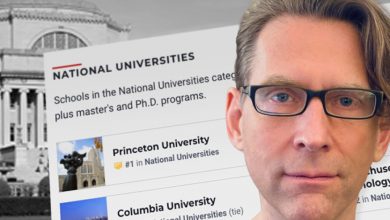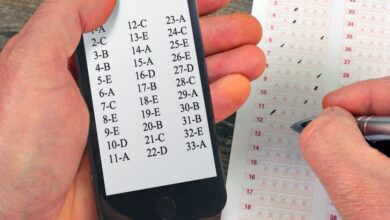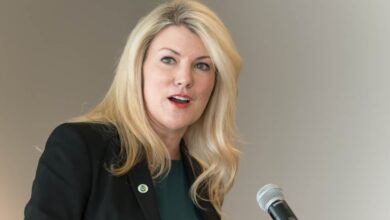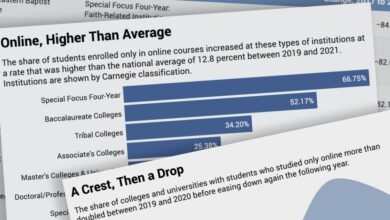Good News for HBCUs
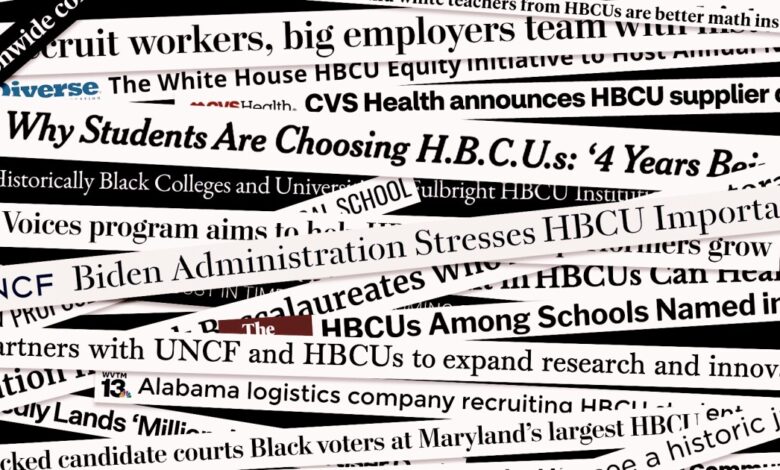
[ad_1]
What sent this video viral — over 1 million plays, 200,000 likes, 7,000 comments — was that the students were members of the first gymnastics team at a historically Black college.
“I’m sooo for HBCU’s getting gymnastics teams,” said one commenter. “This means so much to me and I’ve never done gymnastics,” another comment read. “I can imagine my future daughter, little cousins, etc going.”
Fisk University was once the crown jewel of Black colleges. Its founders set the course for what Black intellectualism could be, its Jubilee Singers were renowned worldwide for their Negro spirituals, and its professors trained some of America’s most-vaunted civil-rights leaders, including W.E.B. DuBois and John Lewis.
But for several decades, Fisk has been plagued by a series of financial and leadership challenges. The university has seen four presidents since 2015; its most recent president was fired abruptly in August.
In the media, the university has been consistently portrayed as “embattled,” “cash-strapped,” “poorly run,” and “on the brink of closure.” That reputation was solidified in 2010, when administrators took the controversial step of plugging a budget gap by attempting to sell off part of a $74-million collection of paintings donated by the artist Georgia O’Keeffe. The move enraged art enthusiasts who, during a drawn-out legal battle, accused the university of violating O’Keeffe’s intentions. (Fisk administrators ultimately backed down.)
Now, a decade later, a 52-second TikTok video, crafted by an 18-year-old gymnast, Zyia Coleman, had Fisk’s public-relations office fielding calls from media outlets across the country. And for once, they didn’t ask about the art.
“Making history,” declared an NBC News headline. “Fisk University Women’s Gymnastics Stuns …” Black Enterprise said. “Do you not realize the magic and power of what you are doing?” the singer Jennifer Hudson told five of the team’s members on her network television show before presenting them with an oversized $25,000 check.

Martin B. Cherry, For the Chronicle
What’s happened at Fisk is indicative of a broader phenomenon: For a half century, Black colleges have frequently been portrayed as the basket cases of higher ed. Unflattering media attention perpetuated a public perception that had a cyclical, compounding effect: Negative coverage of financial trouble led to fewer philanthropic contributions and lower enrollment, which led to more financial trouble.
Now HBCUs are suddenly awash in glorifying headlines. They are touted as engines of economic mobility, a refuge for Black students, and the apex of Black culture. The United Negro College Fund, which advocates for and supports private HBCUs, raked in over $215 million in 2021, a record-breaking amount. Within the past two years, MacKenzie Scott, the ex-wife of Jeff Bezos, donated more than $500 million to over 20 Black colleges. The federal government last year set aside more than $6.5 billion for HBCUs.
This month Howard University announced that it has raised over $122 million in research dollars, a crucial step toward it becoming the first HBCU recognized as an R1 research university, which enables the institution to conduct more cutting-edge research.
Meanwhile, enrollment at some Black colleges, namely Morehouse College, Morgan State University, and North Carolina A&T State University, is up, despite a climate of overall enrollment declines, especially for Black students.
A confluence of factors explains this shift in HBCU fortunes: the 2020 Black Lives Matter protests, outsized attention from Black celebrities, many of whom graduated from Black colleges, and a sustained public-relations campaign by HBCU advocates. Moreover, as Fisk’s viral TikTok video showed, social media has placed more control over a colleges’ narrative directly into the hands of students and alumni.
Now HBCU leaders are openly questioning how long the media blitz will last, if they can adequately exploit the moment, and if the uptick in attention will turn into enough philanthropic and political support to meet their growing needs.
At Fisk, where enrollment swung from 600 students in 2017 to over 1,000 this fall, the fleeting opportunity to polish their blemished image makes these questions acute and immediate.
“We’re at an incredibly exciting inflection point,” said Jens Frederickson, Fisk’s executive vice president. “Within the confines of what we were dealt, I don’t think we could’ve done any better. But there’s a difference between surviving and really succeeding. I think we have proven that we’re long past survival, but what would it look like to really succeed?”
Student activists have staged weeks-long protests over inadequate services and unwelcoming campuses. Faculty members bemoan tenuous job security, unsustainable workloads, and poor pay. Debates over free speech, race, gender, and sexuality have reached a feverish pitch, and higher ed is often at the red-hot center of controversy.
Colleges have hired reams of public-relations and marketing specialists to protect their brands. Yet public confidence in higher education’s ability to lead the country in a positive direction has dropped from 69 percent in 2020 to 55 percent in 2022, according to a recent survey conducted by New America.
It’s an all-too-familiar predicament for administrators at Black colleges who for more than a century have fended off negative attention, racist stereotypes, and the view that HBCUs are no longer necessary in a racially integrated society.

Martin B. Cherry, For the Chronicle
There are commonalities. All HBCUs share a unique history of being established for the sole purpose of educating formerly enslaved Black people at a time when most states were politically hostile toward Black residents receiving an education. And HBCUs serve a disproportionate number of Pell-eligible students, who tend to have more difficulty making it to and through college.
In media coverage, the best HBCUs are typically grouped with the worst, and when one is losing enrollment and is in fiscal distress, journalists are quick to conclude that they are all losing enrollment and are in fiscal distress. Their HBCU identity almost always trumps their other identities.
In 2011, Marybeth Gasman, a professor of education at Rutgers University, examined over 300 news articles written about Black colleges. She found a pattern. Coverage focused on how HBCUs were able to “do more with less,” overly emphasized turmoil with HBCU leadership, and treated Black colleges as wholly separate from other colleges. When journalists wrote about governance, leadership, student or faculty issues, they almost never used a Black college or university as an example.
“HBCUs have experienced intense scrutiny from the beginning,” Gasman said in a recent interview with The Chronicle.
She points to a 1967 study in the Harvard Educational Review as the origin of many of the tropes about HBCUs. In the article, published just as Black Americans were allowed to enroll in majority-white colleges for the first time, the sociologists Christopher Jencks and David Riesman, two Harvard professors, described Black colleges as “academic disaster areas” — “an ill-financed, ill-staffed caricature of white higher education.” They considered it “unlikely that any all-Negro school will ever have a first-rate graduate professional program.” And they said that the only Black medical schools at the time, which were at Howard University and Meharry Medical College, would have been closed if they weren’t the main sources of doctors willing to assist Black patients.
Mainstream news outlets, from Time and Newsweek to The New York Times, wrote about the study. (Time refused to publish a letter from the president of UNCF, which called into question many of the study’s findings, according to Gasman.)
This unflattering portrait percolated over the decades, and a narrative of deficiency took hold.
Every story should begin with our 150 years of success. It’s critical for any institution’s ability to stay on the map. You have to tell your own story.
In 2010, the economists Roland G. Fryer Jr. and Michael Greenstone conducted a study of graduation rates, test scores, and graduates’ wages, concluding that “HBCU attendance appears to retard Black progress.” A few months later, Jason L. Riley echoed that sentiment in The Wall Street Journal, where he is a member of the editorial board. “Black colleges are at a crossroads,” he wrote. “At one time Black colleges were an essential response to racism. They trained a generation of civil-rights lawyers and activists who helped end segregation. Their place in U.S. history is secure. Today, however, dwindling enrollments and endowments indicate that fewer and fewer Blacks believe that these schools, as currently constituted, represent the best available academic choice.”
A 2018 UNCF study found that many high-school counselors don’t even mention to their seniors the prospect of going to HBCUs.
With their collective reputation in disrepair, HBCU administrators went on the offensive. In 2019, UNCF published and widely promoted “The HBCU Effect,” a study touting the things Black colleges do well. Though HBCUs account for 3 percent of colleges, they are responsible for 17 percent of the bachelor’s degrees and a quarter of the STEM degrees earned by Black students. Three years after graduation, HBCU students earn $10,000 more than students with a high-school diploma. Within six years of graduating, HBCU students, who are typically Pell eligible, end up surpassing their family’s income level. Ten years after degree completion, the income of first-generation HBCU graduates is on par with non-first-generation students.
The Black Lives Matter protests, which took off in 2014 and peaked after George Floyd’s murder in the summer of 2020, drew attention to higher education’s racist past and the ways Black students continue to experience racism on majority-white campuses. Journalists explored how HBCUs have been financially disenfranchised, comparing the public funding of Black colleges to majority-white colleges.
And then, suddenly, HBCUs were in vogue.
In 2019, pop singer Beyoncé said during a video montage highlighting Black college culture that she wished she had gone to an HBCU. Two years later, rapper Megan Thee Stallion received her health-administration degree from Texas Southern University. Vice President and Howard alumna Kamala Harris touted on the campaign trail that attending an HBCU was “one of the most important aspects of my life.” Football Hall of Famer Deion Sanders took a job as head coach of Jackson State University’s football team, imploring top Black high-school athletes to ditch powerhouse schools for HBCUs, many of whom did.
To get a sense of how drastically the perception of HBCUs has changed in the last few years, consider the publicity around this year’s HBCU Week at the White House, compared to the one held in 2017.
That year, HBCU presidents drew the ire of many Black Americans for posing with former President Donald J. Trump. (Kellyanne Conway was caught in the photo with her feet on a couch, and the photo quickly turned into a meme.) It sparked a rash of student protests on Black college campuses that accused administrators of being sellouts.
But this year, thousands of people and dozens of vendors crowded the September event in Washington, D.C., which featured a host of panels on recruiting and retaining Black students, advancing research and innovation, expanding federal student aid, and developing industry partnerships.
“From the Fisk Jubilee Singers who performed for Queen Victoria to the female mathematicians who offered critical intelligence to NASA’s first human space flights, to the brilliant legal scholars who helped dismantle structural segregation, and so many of the giants of the Civil Rights movement who dedicated their lives to lifting up the rights and dignity of all Americans, HBCUs have empowered graduates to form America’s cultural identity, write our national story, and safeguard this country’s most fundamental values,” President Joe Biden said in a proclamation.

Martin B. CHerry, For the Chronicle
News coverage highlighted Fisk’s status as an HBCU when the university spent more than three quarters of its endowment to keep afloat in 1976, when its enrollment plunged after the attempted sale of the Georgia O’Keeffe art in 2010, and when its president, Kevin D. Rome, resigned in 2020. Reporters pointed to Fisk’s troubles as evidence of the diminished relevance of Black colleges, even though at many HBCUs enrollment was growing.
“Today, Fisk has 645 students, and like other HBCUs whose enrollments are 1,000 or less, the prognosis for survival is not good,” stated a 2014 article in The New York Times.
During a visit to Fisk’s Nashville campus in September, administrators got visibly frustrated when discussing how media coverage of fired and disgraced presidents, the art they almost sold, and the constant specter of financial crisis have subsumed the university’s storied civil-rights history, its recent enrollment rebound, establishment of a social-justice center, and the many uplifting stories they see every day among their students, many of whom are the first in their families to attend college.
Walking into the office of Brandon Owens, dean of Fisk’s library and a second-generation Fiskite, was like stepping through a time machine. A wooden desk from the Harlem Renaissance era stood in the center of the room. Books signed by W.E.B. Du Bois, Langston Hughes, and Booker T. Washington lined the shelves. Framed photos of the first Black fraternity for graduate students, Sigma Pi Phi, adorned the walls.
Fisk has had its struggles like every “dysfunctional family,” he said when reflecting on the amount of bad news that’s plagued the university. But “every story should begin with our 150 years of success. It’s critical for any institution’s ability to stay on the map,” Owens said. “You have to tell your own story.”
The idea for a gymnastics team came about in a haphazard way.
Frank Simmons, a Fisk alumnus and trustee, was disappointed to hear his niece, Jordynn Cromartie, say during a Thanksgiving family dinner that she wants to go to a Black college but none of them have a gymnastics team.
At Simmons’ suggestion, the university set aside scholarship money and hired Corrine Tarver, a gymnastics coach from the University of Pennsylvania.
It was a jackpot move. Cromartie passed up a place on the gymnastics team at Utah State University, and another promising athlete, Morgan Price, decommitted from the University of Arkansas, sparking a flurry of stories in local sports blogs.
Their coaches and friends told them they were making a mistake. An HBCU, Price was told, lacked adequate facilities, NCAA status, a brand that could advance her sports career.
Many of the team’s gymnasts said in interviews with The Chronicle that they had never heard of Fisk before applying, either its storied history or its scandals. But they craved an environment in which their hair, their dance style, their slang, their state of being, was affirmed.
“Growing up in the sport of gymnastics, I was always around people who didn’t look like me,” Price said. “If I went to an HBCU and did gymnastics, I would be doing the sport I love with girls who look just like me and be able to be around them all the time.”

Martin B. CHerry, For the Chronicle
The team is practically inseparable. They have sleepovers in each other’s dorms and laugh about trying to fit three teammates into one twin-sized bed.
On a Sunday morning in September, their first practice of the season, the team, clad in blue leotards with the word “Fisk” embroidered across their suits, was followed by a film crew, a reporter from The Chronicle, and a few parents.
One student packed her dreadlocks into a ponytail, another helped her teammate gather her curls into a bun, and another tied her braids out of her face. Sunlight beamed through the windows of the Nashville Gymnastics Training Center as “Run the World (Girls)” by Beyoncé played from a nearby speaker.
“Every other team is not like ours,” said Kaylei McDonald, a 19-year-old Fisk gymnast. “We’re one of a kind.”
[ad_2]
Source link


